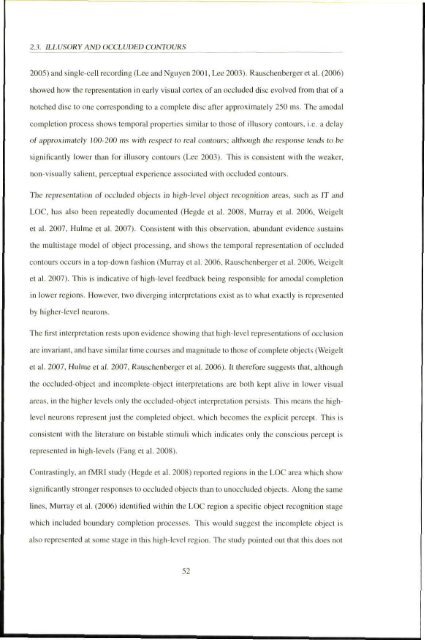Bernal S D_2010.pdf - University of Plymouth
Bernal S D_2010.pdf - University of Plymouth
Bernal S D_2010.pdf - University of Plymouth
You also want an ePaper? Increase the reach of your titles
YUMPU automatically turns print PDFs into web optimized ePapers that Google loves.
2.3. ILLUSORY AND OCCLUDED CONTOURS<br />
2005) and single-cell recording (Lee and Nguyen 2001, Lee 2003). Rauschenbergeret al. (2006)<br />
showed how the representation in early visual cortex <strong>of</strong> an occluded disc evolved from that <strong>of</strong> a<br />
notched disc to one corresponding lo a complete disc after approximately 250 ms. The amodal<br />
completion process shows temporal properties similar lo those <strong>of</strong> illusory conlours, i,e, a delay<br />
<strong>of</strong> approximately 100-200 ms with respect to real contours; although the response tends to be<br />
significantly lower Ihan for illusory contours (Lee 2003). This is consistent with the weaker,<br />
non-visually salient, perceptual experience associated with occluded conlours.<br />
The representation <strong>of</strong> occluded ohjecis in high-level objcci recognition areas, such as IT and<br />
LOC, has also been repeatedly documented (Hegde et al. 2008, Murray et al, 2006. Weigelt<br />
et al. 2007, Hulme el al. 2007). Consistenl with this observation, abundant evidence sustains<br />
the multistage model <strong>of</strong> object processing, and shows the temporal representation <strong>of</strong> occluded<br />
contours occurs in atop-down fashion (Murray el al. 2(K)6, Rauschenbcrger el al. 2006. Weigell<br />
et al. 2007), This is indicative <strong>of</strong> high-level feedback being responsible for amodal completion<br />
in lower regions. However, two diverging interpretations exist as to what exactly is represented<br />
by higher-level neurons.<br />
The first interpretation rests upon evidence showing ihat high-level represenlalions <strong>of</strong> occlusion<br />
are invariant, and have similar time courses and magnitude to those <strong>of</strong> complete objects (Weigelt<br />
ei al. 2007, Hulme et al. 2007, Rauschcnberger el al. 2006). It therefore suggests that, although<br />
the occluded-objecl and incomplete-object interpretations are both kept alive in lower visual<br />
areas, in ihe higher levels only ihe occluded-object interpretation persists. This means the high-<br />
level neurons represent just the completed object, which becomes the explicit percept. This is<br />
consistenl with the lileralure on bistable stimuU which indicates only ihe conscious percept is<br />
represented in high-levels (Fang ei al. 2008).<br />
Contrastingly, an fMRl study (Hegde et al- 2(X)8) reported regions in ihe LOC area which show<br />
significantly stronger responses to occluded object,s than to unoccluded objects. Along the same<br />
lines, Murray et al. (20O6) identified within the LOC region a specific object recognition stage<br />
which included boundary completion processes. This would suggest ihc incomplete object is<br />
also represented al some stage in this high-level region. The siudy pointed out thai this does not<br />
52

















